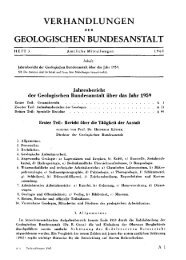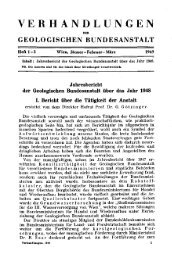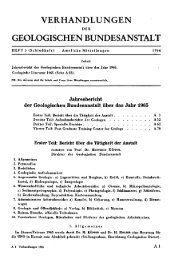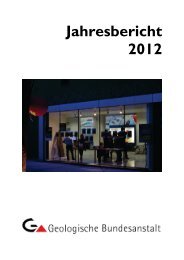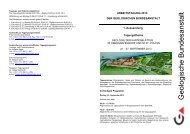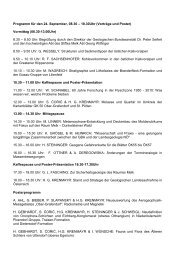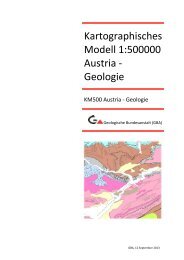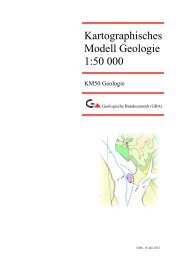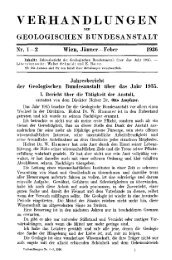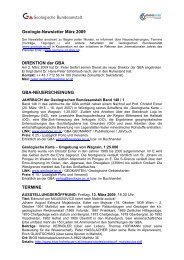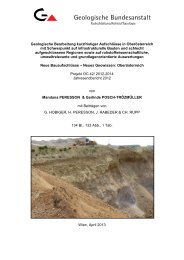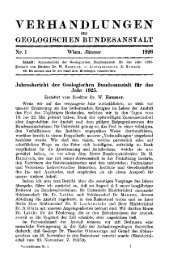Field Trip B TRIASSIC CONODONT LOCALITIES OF THE ...
Field Trip B TRIASSIC CONODONT LOCALITIES OF THE ...
Field Trip B TRIASSIC CONODONT LOCALITIES OF THE ...
Create successful ePaper yourself
Turn your PDF publications into a flip-book with our unique Google optimized e-Paper software.
History of geologic research in the Salzkammergut<br />
By<br />
H. LOBITZER (Geological Survey of Austria)<br />
The stratigraphy of the Alpine Triassic mainly is based on the publications by F. v. HAUER (1853)<br />
and subsequent papers by E. v. MOJSISOVICS (1873-1902): 1892: Hallstatt Zone. Presently a revision<br />
of stratigraphic type localities and ammonites is carried out- by L. KRYSTYN and E. T. TOZER<br />
caused by the discovery of G. SCHÄFFER and W. SCHLAGER (e. g. 1969), that most of the fossil<br />
accumulations are either due to synsedimentary tectonic fissures or to faunal condensation, the latter<br />
caused by periods of minimum sedimentation. The tectonic fissures show evidence of repeated opening<br />
(W. SCHLAGER, 1969). Some of the fissures cut through the whole sequence of Hallstatt Limestone<br />
(e. g. fissures with Norian sediments in Anisian Hallstatt Limestone!).<br />
Maybe as a consequence of the beautiful countryside as well as of the most complicated geology<br />
of Salzkammergut area the „Hallstatt-Zone" became a „punching-ball" for generations of sediment<br />
geologists and of tectonic speculations. In the early phase of research ^between approximately 1802<br />
— marked by L. v. BUCH's monography — and 1903, the year of the IX. International Geological Congress<br />
in Vienna) stratigraphic problems of the Alpine Mesozoic were the main goal, but also considerations<br />
regarding the bathymetric conditions, the geometry of depositional environments and lithogenesis<br />
were made. In the years 1797-1799 L. v. BUCH travelled jointly with A. v. HUMBOLDT in the<br />
Salzkammergut area (L. v. BUCH, op. cit.). The first results of the investigations of the red colour of<br />
the limestones, of the age and environmental conditions of the salt deposits and of the origin of stratification<br />
were published. The unrivalled genius of the Austrian geologists E. SUESS (1888) gave already<br />
an explanation for the bedding resp. cyclicity of Dachstein Limestone, i. e. cycle emerging and subsequent<br />
weathering of the bedding planes — a simplified model for the „Lofer cyclothems" (A. G. FI<br />
SCHER, 1964). A study by E. v. MOJSISOVICS (1874) represents an early attempt of facies zoning<br />
in Salzkammergut areai E. v. MOJSISOVICS (1903) in one of his last papers summarizes his ideas of<br />
the paleogeographic position of Hallstatt zone. He postulates an in situ position (sediments of Hallstatt<br />
type deposited in channels („Hallstätter Kanäle") cutting through the reefoid Dachstein Limestone barrier<br />
resp. platform). One year later the fateful paper by E. HAUG & M. LUGEON (1904) marks a fundamental<br />
break through in the history of geological research in Salzkammergut area: the concept of nappe-tectonics<br />
was established. In the sequel the „nappists" entered into competition with the „autochthonists".<br />
L. KOBER and his school (e. g. W. MEDWENITSCH, A. TOLLMANN up to a few years<br />
ago, and others) plead for an extreme nappism. On the other hand C. DIENER, K. LEUCHS, F.<br />
TRAUTH and in modern time H. ZANKL and especially W. SCHLAGER and his group followed the<br />
autochthonous concept of E. v. MOJSISOVICS (1903) in modified versions. The present author tends<br />
to accept this concept, too.<br />
It would exceed the scope of this paper to enumerate all the famous people doing research in this<br />
area in the past century and the interested reader can refer to the book by A. TOLLMANN (1976) for<br />
this purpose or to the short review by W. JANOSCHEK & A. MATURA (1980) respectively.<br />
References<br />
BUCH, L. v. (1802): Geognostische Beobachtungen auf Reisen durch Deutschland und Italien.Vol. 1,<br />
320 p., (Haude & Spener), Berlin.<br />
FLÜGEL, E., LOBITZER, H., SCHÄFFER, P. & ZANKL, H. (1975): Mesozoic shallow and deeperwater<br />
facies in the Northern Limestone Alps. — In: FLÜGEL, E.: International Symposium on Fossil<br />
Algae. — Guidebook, 55—146, Erlangen.<br />
HAUER, F. v. (1853): Über die Gliederung der Trias-, Lias- und Juragebilde in den nordöstlichen Alpen.<br />
- Jb. Geol. Reichsanst., 4, 715-784, Wien.<br />
HAUG, E. & LUGEON, M. (1904): Sur l'existence, dans le Salzkammergut, des quatre nappes de charriage<br />
superposees. — C. R. Acad. Sei. Paris, 130, Paris.<br />
JANOSCHEK, W. R. & MATURA, A. (1980): Outline of the Geology of Austria. - Abhandl. Geol.<br />
Bundesanst., 34, Wien (in print).<br />
KITTL, E. (1903): Geologische Exkursionen im Salzkammergut (Umgebung von Ischl, Hallstatt und<br />
Aussee). — Guidebook 9. Internat. Geol. Congr., No. 4, 118 p., Wien.<br />
KOBER, L. (1912): Der Deckenbau der östlichen Nordalpen. — Denkschr. Akad. Wiss., math.-naturwiss.<br />
Kl, 88, 345-396, Wien.<br />
67



